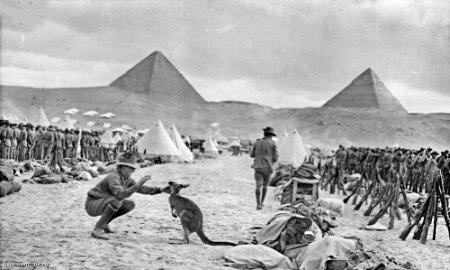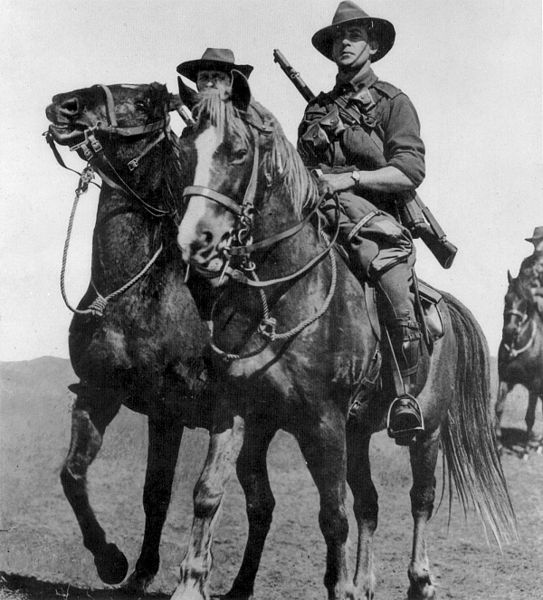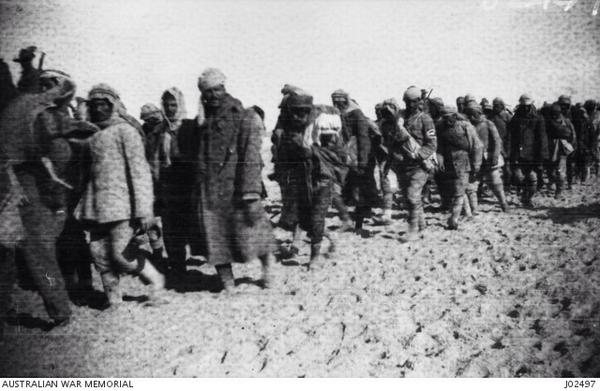Turks Eye Second Attempt to Seize the Suez Canal
Under Scorching Sun, the British Reject Ottoman Force.
Special to The Great War Project
(8-11 August) In early August a century ago, a little remembered battle erupts in the Sinai desert east of the Suez Canal.
It takes place in an Egyptian town called Romani.
It is the second time there is a fight for Romani. The first breaks out early in the war, in 1914. Then the British stop Ottoman forces from crossing the strategic canal and taking control of it.

Australian and New Zealand ANZAC troops in Egypt, summer 1916.
But in the two years since, the Ottomans and the Germans are widely expected to mount a second attack on the Suez Canal. By the summer of 1916, “the Ottomans and their German allies were impatient to proceed,” writes historian Eugene Rogan.
At this moment the Turks are withholding their participation, hoping to enlist Sharif Hussein and his Mecca-based Arab force in the attack on the British.
But before the Turks can enlist the Arabs in the fight at the canal, the Arab Revolt breaks out in the summer a century ago,
Sharif Hussein of Mecca, supported by the British, mounts widespread attacks on the Turks on the Arabian Peninsula.
“The outbreak of the Arab Revolt in June 1916 dashed those hopes and created a new hostile front in the Arab provinces,” reports Rogan.
In response, the Ottoman leaders decide to attack the British in the Sinai, reasoning that success there would undermine the appeal of the Arab Revolt in the Arab provinces.

Map of Battle of Romani, August 1916.
So Rogan writes, in the midst of a scorching summer, when the British least expect it. the Ottomans give “the green light to launch the long-delayed second attack on the Canal Zone,”
The battle centers around the town of Romani in the Sinai desert.
Few remember the Battle of Romani. Most of the war coverage in these days focuses on the Western and Eastern Fronts in Europe.
Romani pits the British against mostly German troops. “With only 16,000 men…it was a much smaller force than the British had anticipated.”
Reports Rogan, “In a feat of remarkable endurance, the [German] soldiers had managed to transport artillery across the desert sands, to compensate for their small numbers with heavy firepower.”
At first the Germans gain the upper ground.
The Germans catch the British, with their Australian and New Zealand ANZAC units, by surprise.

Australian horse brigade, Suez August 1916.
But the Battle of Romani does not end there. “Once alerted,” reports Rogan, “the British flooded Romani with reinforcements to repulse the Turks.”
Quickly the Turks are running out of ammunition and water. Hundreds surrender. In early August, the Germans are losing the battle and they withdraw their heavy guns. Australian cavalry is in hot pursuit.
“The Ottomans were soundly defeated in the Battle of Romani,” writes Rogan. They lose some 1500 soldiers killed or wounded. Four-thousand of their troops are taken prisoner. The British and ANZAC forces lose 200 killed and 4,000 prisoners.
It turns out that for all the fighting in the two years of war, despite all the bloodletting, this is the first British victory over the Ottoman Turks.

Ottoman prisoners at Romani, August 1916.
This battle, though smaller and shorter than most of the other battles in the war at this point, “also represented the final Ottoman attack on British positions in Egypt.”
Elsewhere in the Middle East, the British-backed Arab Revolt is still spreading in the Arabian provinces.
And despite their defeat at Romani, the Turks “still retained the forces and artillery to defend their Palestine frontier,” to the north.
The British begin to plan additional attacks on the Turks in Gaza, and ultimately in Palestine and Jerusalem.
